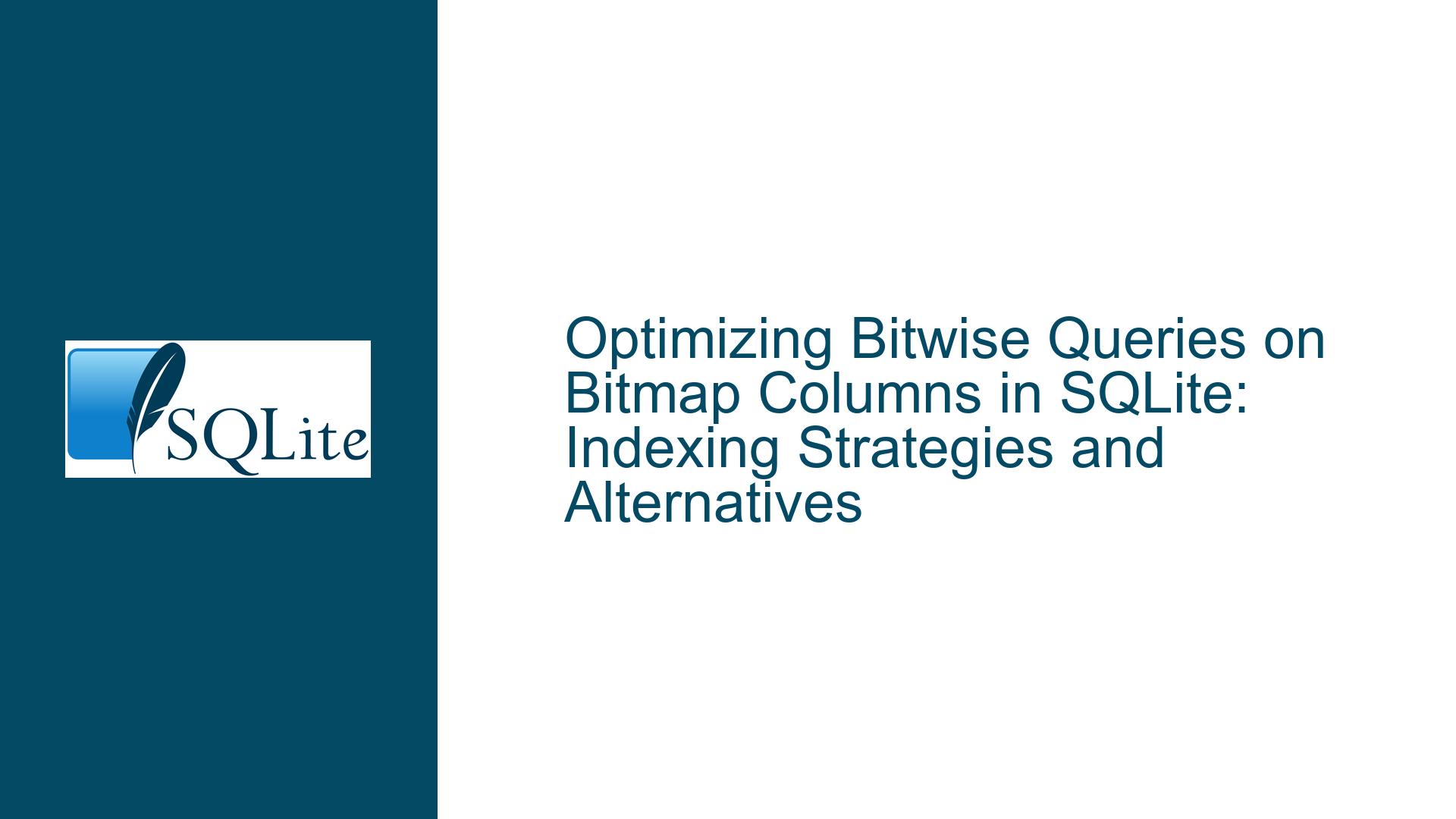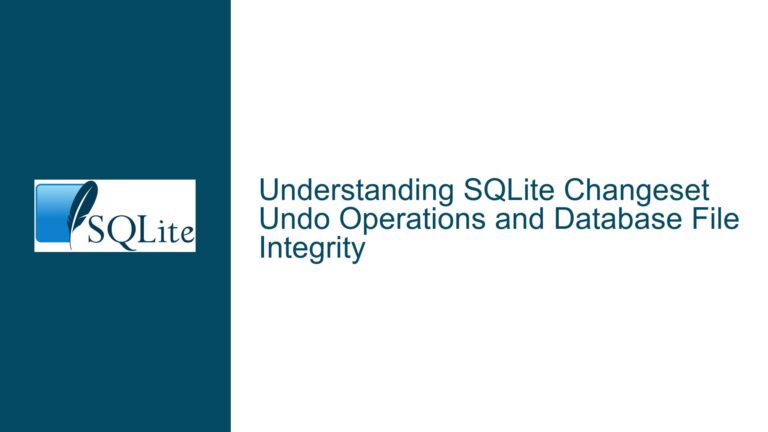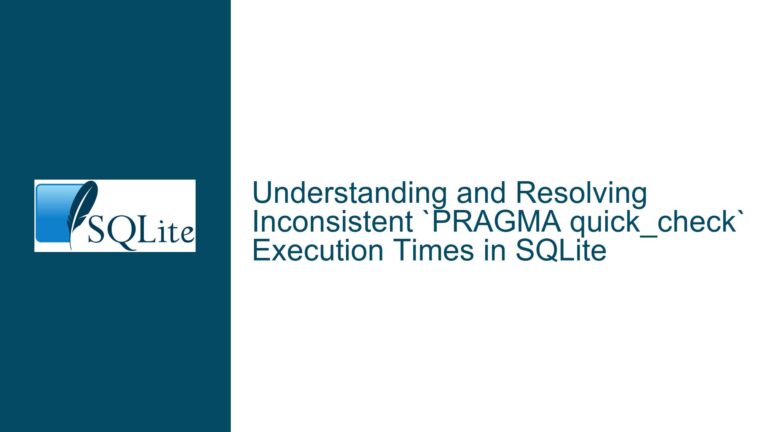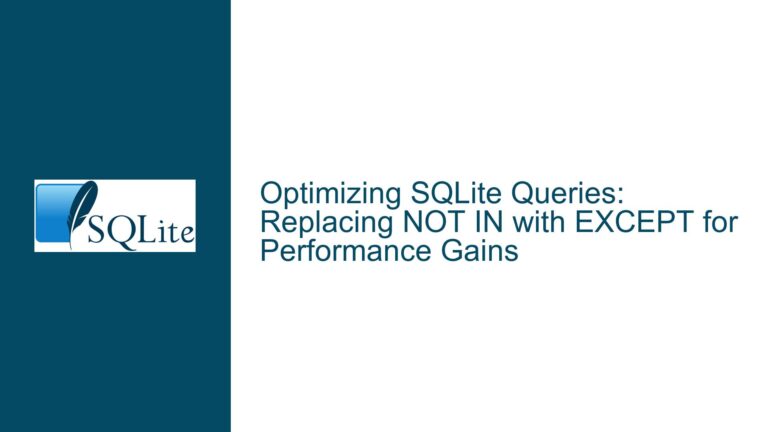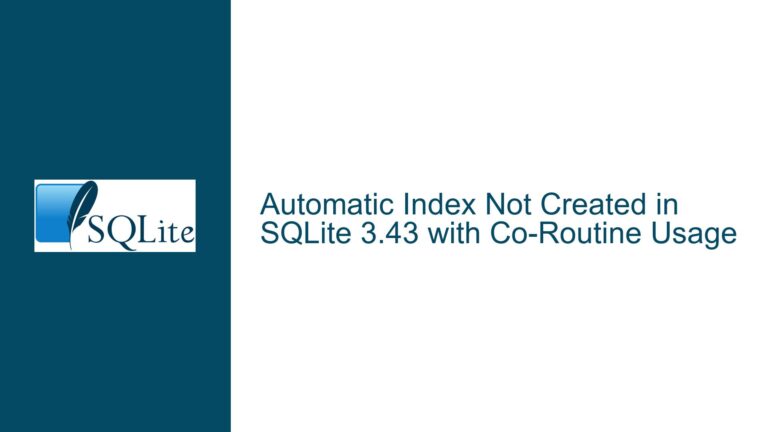Optimizing Bitwise Queries on Bitmap Columns in SQLite: Indexing Strategies and Alternatives
Understanding Bitwise Filtering and Index Limitations in SQLite
Issue Overview
The core challenge revolves around efficiently querying a column storing bitmask values (e.g., statuses in a users table) using bitwise operations like statuses & 7 to check for specific flag combinations. For example, a value of 7 (binary 111) indicates that the first three bits are set, representing flags such as "online," "active," and "premium." The user seeks to optimize queries filtering rows based on these bitwise conditions without sacrificing storage efficiency or requiring frequent schema changes.
SQLite lacks native support for bitmap indexes, which are specialized structures for accelerating bitwise queries. Instead, developers must work with its B-tree index implementation, which orders data lexicographically. This creates a mismatch: B-tree indexes excel at equality or range queries on entire column values but struggle with arbitrary bitwise conditions. For instance, an index on statuses will sort rows by the entire integer value, not individual bits. A query like statuses & 7 could require scanning most or all entries in the index, as multiple unrelated bitmask values might satisfy the condition (e.g., 7, 15, 23, etc.).
The problem is compounded when dealing with numerous flags (e.g., 60+), as storing each flag in a separate column would bloat the schema and require extensive indexing. The user’s proposed workaround—using a single integer column with bitwise operations—avoids schema changes but risks poor query performance due to inadequate indexing strategies.
Root Causes of Poor Bitwise Query Performance
B-Tree Indexes and Bitwise Operations Are Fundamentally Misaligned
- B-tree indexes organize data based on the entire value of a column. For a bitmask column like
statuses, the index orders rows by the numeric value ofstatuses, not individual bits. Queries involving bitwise conditions (e.g.,statuses & 7 != 0) cannot leverage this ordering effectively, as the index does not isolate specific bits. - Example: If
statusesvalues are3(0011),5(0101), and7(0111), an index onstatuseswill sort them as3, 5, 7. A query forstatuses & 4(checking the third bit) would scan all entries, since the index does not group rows by the third bit’s state.
- B-tree indexes organize data based on the entire value of a column. For a bitmask column like
Trade-Off Between Storage Efficiency and Query Flexibility
- Bitmask Column Approach: Consolidating flags into a single integer minimizes storage but forces queries to use computationally expensive bitwise operations. Without targeted indexing, these queries degrade into full-table scans as data grows.
- Separate Columns Approach: Storing each flag as a
BOOLEANcolumn allows efficient indexing (e.g.,CREATE INDEX idx_online ON users(online)), but this increases schema complexity and storage overhead. Adding 60 columns is impractical and violates normalization principles.
Lack of Native Bitmap Index Support in SQLite
- Unlike some databases (e.g., PostgreSQL with its
bitmap_scan), SQLite does not provide built-in bitmap indexes. Developers must emulate this functionality using B-tree indexes, partial indexes, or external extensions.
- Unlike some databases (e.g., PostgreSQL with its
Solutions for Efficient Bitwise Filtering in SQLite
1. Partial Indexes for Targeted Bit Checks
Partial indexes allow indexing a subset of rows based on a WHERE clause. For queries targeting specific bits, create partial indexes that isolate rows where a particular bit is set.
Example: To optimize SELECT ... WHERE statuses & 1 != 0 (checking the first bit):
CREATE INDEX idx_statuses_bit1 ON users(statuses) WHERE (statuses & 1) != 0;
This index includes only rows where the first bit is set. Queries checking this bit will use the index, avoiding a full scan.
Pros:
- Minimal storage: Indexes only cover relevant rows.
- Fast for targeted bit checks.
Cons:
- Requires one index per bit, which becomes impractical for 60+ flags.
- Does not optimize multi-bit conditions (e.g.,
statuses & 7).
2. Expression Indexes for Common Bitwise Conditions
SQLite allows indexes on expressions (via generated columns or direct expressions in indexes). Use this to precompute bitwise conditions and index the results.
Step 1: Add a Generated Column
ALTER TABLE users ADD COLUMN has_flags_1_3 INTEGER GENERATED ALWAYS AS (statuses & 7);
Step 2: Create an Index on the Generated Column
CREATE INDEX idx_has_flags_1_3 ON users(has_flags_1_3);
Query Using the Generated Column:
SELECT id, name FROM users WHERE has_flags_1_3 != 0;
Pros:
- Optimizes multi-bit conditions.
- Maintainable if query patterns are predictable.
Cons:
- Adds storage overhead for generated columns.
- Requires prior knowledge of frequently used bitwise conditions.
3. Normalized Schema with a Flags Junction Table
For long-term scalability, replace the bitmask column with a normalized schema using a junction table to map users to flags.
Step 1: Create Tables
CREATE TABLE users (id INTEGER PRIMARY KEY, name TEXT);
CREATE TABLE flags (id INTEGER PRIMARY KEY, name TEXT);
CREATE TABLE user_flags (
user_id INTEGER REFERENCES users(id),
flag_id INTEGER REFERENCES flags(id),
PRIMARY KEY (user_id, flag_id)
);
Step 2: Create Indexes
CREATE INDEX idx_user_flags_user ON user_flags(user_id);
CREATE INDEX idx_user_flags_flag ON user_flags(flag_id);
Query for Users with Flags 1, 2, or 3:
SELECT u.id, u.name
FROM users u
WHERE EXISTS (
SELECT 1 FROM user_flags uf
WHERE uf.user_id = u.id AND uf.flag_id IN (1, 2, 3)
);
Pros:
- Flexible: Supports arbitrary flag combinations.
- Space-efficient for sparse flags (stores only active flags).
- Adheres to normalization best practices.
Cons:
- Joins add overhead compared to bitwise operations.
- Requires schema changes.
4. Hybrid Approach: Bitmask Column with Materialized Views
Use a bitmask column for storage efficiency but create materialized views (via triggers) to emulate bitmap indexing.
Step 1: Create a Bitmask Column
ALTER TABLE users ADD COLUMN statuses INTEGER NOT NULL DEFAULT 0;
Step 2: Create Triggers to Update Materialized Views
For each flag, create a table that stores user_id when the flag is active:
CREATE TABLE flag1_users (user_id INTEGER PRIMARY KEY REFERENCES users(id));
CREATE TRIGGER tr_flag1_insert AFTER UPDATE ON users
WHEN NEW.statuses & 1 != 0
BEGIN
INSERT OR IGNORE INTO flag1_users (user_id) VALUES (NEW.id);
END;
CREATE TRIGGER tr_flag1_delete AFTER UPDATE ON users
WHEN NEW.statuses & 1 = 0
BEGIN
DELETE FROM flag1_users WHERE user_id = NEW.id;
END;
Query for Flag 1:
SELECT u.id, u.name
FROM users u
JOIN flag1_users f1 ON u.id = f1.user_id;
Pros:
- Combines storage efficiency with indexed lookups.
- Scales better than partial indexes for many flags.
Cons:
- Complex trigger maintenance.
- Increased write overhead.
5. Leveraging External Tools: Fastbit Virtual Table
For extreme scalability, integrate Fastbit (a compressed bitmap library) via a SQLite virtual table.
Step 1: Compile Fastbit as a Loadable Extension
Download Fastbit and compile it as a SQLite extension.
Step 2: Create a Virtual Table
CREATE VIRTUAL TABLE user_flags_fastbit USING fastbit(
user_id INTEGER,
flag_id INTEGER
);
Step 3: Populate the Table
Insert flag-user mappings into user_flags_fastbit.
Query for Flags 1-3:
SELECT u.id, u.name
FROM users u
JOIN user_flags_fastbit f ON u.id = f.user_id
WHERE f.flag_id IN (1, 2, 3);
Pros:
- Optimized for high-performance bitwise queries.
- Compressed storage.
Cons:
- Requires external dependencies.
- Advanced setup and maintenance.
Final Recommendations
- For small datasets (<100k rows), use partial indexes or expression indexes.
- For large datasets with sparse flags, adopt the normalized schema.
- For write-heavy workloads, consider the hybrid trigger-based approach.
- For enterprise-scale applications, explore Fastbit integration.
Always validate choices with EXPLAIN QUERY PLAN and the SQLite Analyzer to measure index effectiveness and storage impact.
